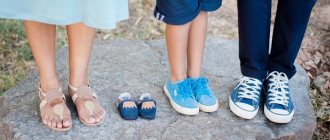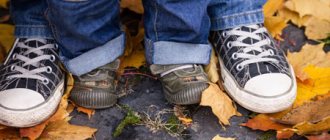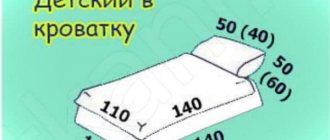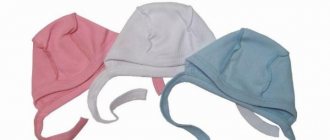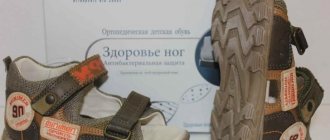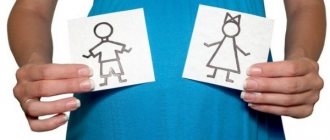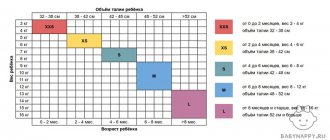The child is constantly growing, periodically there is a need to buy things of a larger size. And if it’s not difficult to decide on clothes, then choosing shoes often poses difficulties. The correct formation of a child’s foot depends on the quality of shoes, shoes or boots that the baby wears If shoes are chosen incorrectly, diseases of the musculoskeletal system (flat feet, foot deformity) may develop.
Trying on children's shoes
Going to the store with a small child to buy new shoes is not an easy task. It is difficult for a baby to try on one pair of shoes after another, patiently answer his mother’s questions, while remaining in one place. And if you need to visit several stores, it’s a real disaster. In addition, parents need to take into account that small children, when answering the question of whether the shoes are suitable, will pay more attention to decorative beads or cars than to convenience . This is due to the structural features of children's legs - the presence of a fatty layer reduces the sensation of pain and discomfort.
But if you are well prepared, you can buy children's shoes without a child. The main thing is to determine the right size.
Classification of children's shoe sizes
The size of a child’s feet in centimeters by age is calculated according to international systems adopted in each country:
- Metric (Russia).
- Shtikhmassovaya (Europe).
- Inch (America and Great Britain).
To correctly determine the size of a child’s feet, you need to know the length of the foot and its width. This will help you choose the appropriate pair of shoes. These results are divided into 2 types of sizes: by fullness and by length .
The child's foot length is the basic measurement for choosing shoes. It is calculated by the distance from the heel to the beginning of the foot. The size of the fullness of the shoe is determined by the circumference of the foot at the widest point.
In Russia, this parameter has a numeric code from 1 to 12:
- 1 – up to a year;
- 1-3 – up to 3 years;
- 1-5 – 3-7 years;
- 1-8 – 8-12 years;
- 1-12 – from 12 years old.
Fullness is calculated using the formula: (Foot circumference in mm*0.25) – (Foot length in mm*0.15) – 17.
The resulting number is rounded up and corresponds to the fullness of the shoe.
In European countries, completeness is indicated by a code from 1 to 17. English completeness is determined by Latin letters from A to F with additional designations of narrowness (2A-6A) and width (2F-6F).
In America they use the literal meaning:
- N – narrow;
- M – average;
- X – wide;
- XW – very wide.
How fast does the leg grow?
Babies grow quickly, and children also have developmental spurts when their height and weight rapidly increase and, accordingly, their legs grow. Because of this, you may need more than one pair of sandals or boots for one season. Then you can come to the store with a pair that has been worn out for several months and just take a size larger. But you need to be careful: the sizing chart may differ from different manufacturers. For some, size 19 is 11 centimeters, for others, for example, 12. Moreover, even in different lines from the same company there are noticeable differences, so the general table is not always reliable.
Careful measurements are also needed when purchasing children's shoes in online stores. Not all of them provide the opportunity to try on and immediately change the chosen pair. So we have to study the necessary values. You must also remember that the smaller the child, the faster his leg grows. Up to 3 years, the size changes on average every 3 months. Children's shoes are usually enough for one season, no more. Although it happens that size 21 sandals, which fit perfectly at the beginning of summer, are too small already in the middle of summer. From 3 to 6 years old, the leg usually grows one size in 4 months, after 6 years - in 5 months.
How to correctly measure a child's leg in centimeters?
Shoe manufacturers often produce products that do not conform to uniform approved sizing systems. Therefore, before purchasing, it is important to know the parameters of the foot, so that in case of a size mismatch, you can find a suitable pair in a different size chart.
To measure the length of a child's foot you need:
- Place paper or cardboard on a flat, hard surface (floor or table).
- Place the child's bare feet on the paper.
- Trace both feet with a pencil.
- Measure the distance along the entire length of the segment.
You can also apply a measuring tape to your baby's foot to get instant results. You can determine your shoe size by adding 1 cm to the resulting length for margin and correlating this number with the size grid.
More accurate data is obtained by measuring the length of both feet of the child, since a deviation of up to 6 mm is possible. In addition, it doesn't hurt to know the fullness of the shoes. It is recommended to carry out the measurement procedure in the evening, since during the day the leg may become larger by several mm.
Different ways to measure foot length in centimeters
First of all, it is recommended to familiarize yourself with the most accurate methods of measuring a child’s feet, which directly determine how long the child can wear the selected pair. And not the least role here is played by the age factor, because the smaller the baby, the more difficult it is to take measurements from his legs, as a result of which an ordinary rope or measuring tape is used.
For older children, copying the foot on paper is ideal. Some parents limit themselves to simply making notches along the heel and big toe, however, this technique is not informative enough, so it is better not to be lazy and completely outline the outline of both feet, after which it is necessary to connect the outermost two points with a straight line and measure this is the distance.
In addition, it is of great importance what kind of shoes is on the agenda, because if you need to buy boots, you should take measurements in warm socks. Another nuance is the different lengths of the feet, which is not a deviation, but requires taking measurements from both feet so that you can choose shoes based on the larger foot.
It is important to remember that measurements should be taken only in the evening, when the leg has become sufficiently trampled, because usually after an active day it increases by as much as 8-10%.
Buying shoes that fit true to size is not the best idea, since there is a high probability that they will be too small for the next season. But adding another full size to the resulting value is also not worth it, since the leg will not receive proper fixation, being in constant tension.
Ideally, add 1 cm to the actual length if you need to buy shoes for a child under 3 years of age, and 0.5 cm for older children whose feet do not grow as rapidly.
See also:
How to dress a child according to the weather - a table for each age
Sizing systems in different countries
International measurement systems have been approved throughout the world. The most common are metric, inch and weight.
The metric system is recognized in the Russian Federation. It is based on the length of the foot in cm. The increment between shoe sizes in the metric system is 0.5 cm.
In European countries, shoes for a child are selected according to the stichmass system . It got its name thanks to the word “shtikh”, which means the difference in shoe sizes. It is 6.67 mm.
The inch system is used in the USA and the UK.
It is based on the length of the foot in inches. Size intervals correspond to 1/3 inch (8.5 mm).
European sizes. Table by age
A child's foot size in centimeters by age in Europe, with the exception of the UK, is indicated by a single number. The English sizing system is based on the American model. The required size is calculated according to the length of the foot in cm.
| Age | Size Europe | Size England | Length, cm |
| 0-6 months | 16 | 0 | 8,3 |
| 16 | 0,5 | 8,9 | |
| 17 | 1 | 9,2 | |
| 17 | 1 | 9,5 | |
| 6-12 months | 18 | 1,5 | 10,2 |
| 18 | 2 | 10,5 | |
| 19 | 2,5 | 10,8 | |
| 19 | 3 | 11,4 | |
| 20 | 3,5 | 11,7 | |
| 20 | 4 | 12,2 | |
| 1-2 years | 21 | 4,5 | 12,7 |
| 22 | 5 | 13 | |
| 22 | 5,5 | 13,3 | |
| 23 | 6 | 14 | |
| 23 | 6,5 | 14,3 | |
| 2-3 years | 24 | 7 | 14,6 |
| 25 | 7,5 | 15,2 | |
| 25 | 8 | 15,6 | |
| 26 | 8,5 | 15,9 | |
| 4-5 years | 27 | 9 | 16,5 |
| 27 | 9,5 | 16,8 | |
| 28 | 10 | 17,1 | |
| 29 | 10,5 | 17,8 | |
| 6-7 years | 30 | 11 | 18,1 |
| 30 | 11,5 | 18,4 | |
| 31 | 12 | 19,1 | |
| 31 | 12,5 | 19,4 | |
| 8-9 years | 32 | 13 | 19,7 |
| 33 | 14 | 20,3 | |
| 33 | 1 | 20,6 | |
| 9-10 years | 34 | 1,5 | 21 |
| 34 | 2 | 21,6 | |
| 35 | 2,5 | 21,9 | |
| 12 years and older | 36 | 3 | 22,2 |
| 36 | 3,5 | 22,9 |
Size chart by foot length
| Foot, length in centimeters | Size |
| 13 | 21 |
| 13,5 | 22 |
| 14 | 22,5 |
| 14,5 | 23 |
| 15 | 24 |
| 15,5 | 25 |
| 16 | 25,5 |
| 16,5 | 26 |
| 17 | 27 |
| 17,5 | 28 |
| 18 | 28,5 |
| 19 | 30 |
| 19,5 | 31 |
| 20 | 31,5 |
| 20,5 | 32 |
| 21 | 33 |
| 21,5 | 34 |
| 22 | 34,5 |
| 22,5 | 35 |
| 23 | 36 |
| 23,5 | 37 |
American sizes. Table by age
Shoe sizes for children in America are also determined according to the length of the child's feet. But due to differences in measurement systems, American sizes are calculated by distance in inches.
| Age | Size (US) | Length in inches | Length in cm |
| 0-6 months | 0,5 | 3,25 | 8,3 |
| 1 | 3,5 | 8,9 | |
| 1,5 | 3,625 | 9,2 | |
| 2 | 3,75 | 9,5 | |
| 6-12 months | 2,5 | 4 | 10,2 |
| 3 | 4,125 | 10,5 | |
| 3,5 | 4,25 | 10,8 | |
| 4 | 4,5 | 11,4 | |
| 4,5 | 4,625 | 11,7 | |
| 5 | 4,75 | 12,1 | |
| 1-2 years | 5,5 | 5 | 12,7 |
| 6 | 5,125 | 13 | |
| 6,5 | 5,25 | 13,3 | |
| 7 | 5,5 | 14 | |
| 7,5 | 5,625 | 14,3 | |
| 2-3 years | 8 | 5,75 | 14,6 |
| 8,5 | 6 | 15,2 | |
| 9 | 6,125 | 15,6 | |
| 9,5 | 6,25 | 15,9 | |
| 4-5 years | 10 | 6,5 | 16,5 |
| 10,5 | 6,625 | 16,8 | |
| 11 | 6,75 | 17,1 | |
| 11,5 | 7 | 17,8 | |
| 6-7 years | 12 | 7,125 | 18,1 |
| 12,5 | 7,25 | 18,4 | |
| 13 | 7,5 | 19,1 | |
| 13,5 | 7,625 | 19,4 | |
| 8-9 years | 1 | 7,75 | 19,7 |
| 1,5 | 8 | 20,3 | |
| 2 | 8,125 | 20,6 | |
| 9-10 years | 2,5 | 8,25 | 21 |
| 3 | 8,5 | 21,6 | |
| 3,5 | 8,625 | 21,9 | |
| 12 years and older | 4 | 8,75 | 22,2 |
| 4,5 | 9 | 22,9 |
Sizing charts for boys and girls
The size of a child's foot in centimeters by age may vary depending on gender. Boys usually have a slightly larger shoe size than girls. The table shows the average sizes for boys and girls according to their age.
Numerical values of the length and width of the foot in centimeters will help you easily find out the size of a child’s feet within any measurement system, and tables with sizes can be used to predict future size by age
Actual size depends on genetics, children's build and growth rate. The above data will help suggest the possible shoe size as children grow older.
| Size | Boys age | Size | Girls age |
| 19 | 6 months – 3 years | 19 | 6 months – 3 years |
| 20 | 20 | ||
| 21 | 21 | ||
| 22 | 22 | ||
| 23 | 4 | 23 | 4 |
| 24 | 24 | ||
| 25 | 25 | ||
| 26 | 26 | 5 | |
| 27 | 5 | 27 | |
| 28 | 28 | 6 | |
| 29 | 29 | ||
| 30 | 6 | 30 | |
| 31 | 31 | ||
| 32 | 32 | 7 | |
| 33 | 7 | 33 | 8 |
| 34 | 8 | 34 | 9 |
| 35 | 9 | 35 | 10 |
| 36 | 10 | 36 | 11 |
| 37 | 37 | 12 | |
| 38 | 11 | 38 | 13 |
| 39 | 12 | 39 | 14 |
| 40 | 13 | 40 | 15 |
| 41 | 14 | 41 | 16 |
| 42 | 15 | ||
| 43 | 16 | ||
| 44 |
Foot size at different ages
But how to choose shoes so as not to make a mistake with the size? When buying your first shoes, that is, booties for newborn boys and girls, this is usually not so important. After all, the baby is not walking yet, the main thing is that they are not noticeably small for him and do not fall off his feet. But if we are talking about the first steps, then you have to pay close attention to convenience. Finding suitable sandals is not that difficult; how they fit is clearly visible when you try them on. But with shoes and boots it’s more difficult. The table can tell you the approximate dimensions.
- In children under three months of age, the leg does not exceed 9.5 cm. It is this value that you should focus on when choosing your first booties. European mesh defines the length as size 16-17.
- By 6 months the leg grows to 10.5 cm and size 17-18.
- A one-year-old baby's feet are on average 11 to 12 cm, that is, size 19.
- At 1.5 years, the leg is about 13-13.5 cm - size 20 or 21.
- At two years old - 14.5 cm and size 24.
- At 3 years old - 15.5 cm - size 25.
- At 3.5 years old - 16 cm and size 26.
- At 4 years old - 17 cm and size 27.
- At 4.5 years old - 17.5 cm and size 28.
- At 5 years old - 18 cm and size 29.
Of course, any table provides only average values. A particular child’s leg may differ significantly from the average, and in any direction. Some children grow faster, others slower, this affects both height and foot size. In addition, boys are often larger than girls. Therefore, to determine the exact length of the foot, it must be measured.
Rules for measuring feet in newborns and children under one year old
It’s worth knowing the size of a newborn’s feet not only to buy the first booties. The length of the feet in centimeters is one of the signs of a child’s development by age. On average, in full-term babies, the first length rarely exceeds 7-9.5 cm.
To measure the feet of a child under one year old, you need to take a measuring tape or regular thread. The edge of the thread is applied to the base of the child's big toe and pulled to the end of the heel. The resulting segment is measured with a ruler. The same manipulations are carried out with a measuring tape, the use of which does not require additional measurement with a ruler.
What should be the length reserve for children's shoes?
Having extra length in shoes for children is essential. The supply is needed not at all in order to choose a pair for a child to grow into, but for comfortable wearing of shoes. To determine the reserve distance, add from 0.6 to 1 cm to the length of the foot along the insole, depending on the season.
So for sandals and sandals there will be enough margin of 6-8 mm, for sneakers and sneakers – 8-10 mm. Winter shoes require a margin of 10-15 mm to be able to put on socks without losing comfort.
Such a large margin is necessary to ensure that the leg is positioned correctly when walking from a physiological point of view. During movement, the size of the foot can increase by up to 0.7 cm. Having space in the shoe gives room to push and eliminates pressure, bending of the toes, providing comfort and room for growth.
In addition, do not forget about the fullness of the shoes. Full legs require an increase in stock by 2-3 mm, while thin feet require narrower models.
DIY shoes for kids
If you have basic knitting or cutting and sewing skills, give your baby his first pair of soft shoes, made with his own hands. This will bring pleasure to both you and your baby, since the shoes will be made individually to fit the size of the foot, with a unique design, and most importantly, with love for the baby. Depending on your desires and abilities, you can sew leather slippers, felt shoes, or choose a simple pattern for knitting booties.
How to identify tight shoes?
The size of a child's foot in centimeters by age up to 5-7 years changes very quickly. The foot continues to develop from birth to age 8. During this period, the muscles and cartilage tissue become stronger and take on their proper appearance and shape, so it is important for the child’s health to wear shoes that fit.
To avoid making a mistake in your choice, you need to measure your foot length every few months. This practice will allow you to determine in time whether the previous pair of shoes has become too tight. After 4 years, it is enough to update the size data every six months, since every year the foot will lengthen more slowly.
For many children, an adult shoe size can be formed by the age of 13-14, when the foot stops growing. This happens more often in girls. This phenomenon is associated with the fact that girls develop faster than boys. Over the next years, the leg may increase slightly in fullness or length within 2-3 mm.
Determining that a child has grown out of shoes is quite simple. Many children give signals themselves, not wanting to put it on. After returning from a walk, you need to take a good look at your child’s feet.
The presence of redness, dents in the skin, and calluses indicates that it is time to change your old shoes.
Parents need to carefully monitor the growth of their child’s feet and the appearance of their feet in shoes. The heel hanging over the heel or the toes sticking out at the front of the sandal also indicates that the shoe is too tight. Due to the fact that children's feet are protected by a layer of fat, they may not feel discomfort, so it is important to observe the baby's gait and the position of the foot in the shoe.
How to make sure your shoes are too small
A child's foot grows quickly. Thus, schoolchildren and preschool children most often have to change two shoe sizes per year. The youngest, from 2 to 4, have 3 sizes. And before reaching the age of two, the length of the baby’s foot increases by an average of 5 mm every two months. Periods of uniform increase may be followed by slower growth or, conversely, sharp jumps. Therefore, it is almost impossible to predict what shoe size a child will need in six months or a year. Measure the foot size of babies once every 2-3 months, and for older children - once every six months.
- Check your baby's feet. Rubbing, redness, calluses, and bent toes indicate that the shoes are already too small.
- Press on the toe of the shoe to feel the placement of your toes. The free space between the edge of the shoe and the big toe should be up to 15 mm.
- The tightness and fullness of the toe of the shoe with a normal (loose) fit of the tongue indicates the need to purchase a new pair.
- Pay attention to the heel of the shoe. Sagging of the back down to the heel occurs only if the leg has outgrown this size.
Common mistakes parents make
Good shoes help in the development of a child’s foot, do not violate the integrity of the bones and do not deform them. Negligence in choosing children's shoes can lead to flat feet and other health problems in the future.
The most common mistakes when choosing shoes for a child:
- Soft back. The heel of children's shoes needs to be rigid and solid. There should be no slits, inserts or decorative elements. The top of the back of a good shoe is usually slightly rounded and made of a dense material. Shoes with a hard back should be chosen until the child is 10-12 years old, until the foot is fully formed.
- Open heel. To ensure the necessary fixation of the ankle, shoes for any season must have a closed heel. Up to 5 years of age, it is possible to wear flip-flops for a short time to go to the beach or pool.
- Lack of instep support. You should not choose shoes without arch support. This part is used to prevent flat feet and support the arch of the child's foot. Too much arch support can also harm the formation of bone tissue in the foot.
- Hard sole. The sole of the shoe must be solid, made of porous rubber, polyurethane or rubber. This sole does not slip and provides comfort to the child’s feet. A sole made of high-quality material should bend well in the area of the arch of the foot and under the toes. There shouldn't be any flexibility elsewhere.
- Thin sole without heel. A sole that is too thin can affect your child's posture and gait. Physiologically correct would be a sole with a small heel for the transition between the toes and the heel. This will ensure that the child’s foot rolls smoothly from heel to toe. This will provide balance support and eliminate stooping and shuffling. For children, a heel of up to 0.5 cm is suitable, and for children under 7-10 years old - 1.5 cm. For teenage children, you can choose shoes with a heel of 3-4 cm.
- Narrow toe. The toe of children's shoes should be wide and rounded, spacious enough to allow the toes to move. Toes pressed tightly against each other provoke poor circulation in the feet. In addition, insufficient toe support changes the distribution of weight and pressure on the child's feet.
- During fitting, some parents insert their finger between the heel of the shoe and the child's heel to assess the fit. Such actions will not help in this matter, since children unconsciously bend their fingers, thereby creating a small free space at the back.
- Buying orthopedic shoes. Orthopedic shoes should be purchased only according to the indications of a pediatric orthopedist, as they are used for certain foot pathologies. A healthy child can purchase orthopedic insoles.
- Early wearing of shoes. Parents who put on their child's first shoes from the first months of life are doing the wrong thing. The baby will need shoes no earlier than 9-12 months, when he learns to walk. Shoes should only be worn outdoors. At home, you should allow your child to walk barefoot and preferably without socks.
- Wearing out old shoes. Each child wears down their shoes in a certain way while walking. Wearing shoes after another child can affect the development of your baby's feet.
Tips for choosing high-quality and comfortable children's shoes
Choosing shoes for a child that will last a long time and be comfortable to wear is always accompanied by a lot of questions. Recommendations for choosing a good material for children's shoes and information about the features of fitting will help you choose the best option.
The following tips should be followed:
- Shoes with laces are considered the best for keeping baby's feet in place. But there is a risk of falling due to the fact that the laces often come undone. Models with Velcro provide a weaker hold, but can be easily unfastened, allowing the baby to learn to put on his own shoes.
- The material of the shoes is of no small importance . The upper part of the shoe and the sole can be made of synthetics, and the inner surface of the pair is recommended to be made of natural fabrics, since the child’s foot is in direct contact with it.
- The main requirements for the material of children's shoes are resistance to wear , hygiene and safety. Comfort is also important, so the fabric should be flexible and pliable. Modern materials are created from high-tech raw materials that are capable of removing excess moisture and ensuring air circulation inside the shoes. Absorbent insoles absorb liquid, after which they can be washed in a washing machine.
- For the cold season, shoes made of genuine leather are ideal . This material follows the shape of the foot and adapts to it, which eliminates the appearance of calluses and chafing. Soft leather stretches and bends well, retains heat.
- Textile models are suitable for summer . Cotton, denim, felt, linen, felt, and wool are used to make them. These materials do not cause allergies and are hygienic to wear. However, their softness does not allow the child’s heel to be firmly fixed, so orthopedists recommend choosing summer shoes made from combined materials. The toe in such shoes can be textile, and the heel can be leather.
- In order not to make a mistake with the shoe size when trying on, you need to monitor the position of the child’s foot. Toes should not curl in the toes of the shoes or hang beyond them. The arch support should be located exactly under the arch of the foot.
- To correctly determine the reserve, you can remove the insole from the shoe and place the baby’s bare foot on it. The main thing is to correctly fix the heel and estimate the distance from the beginning of the insole to the child’s fingertips.
- If it is not possible to remove the insole , you can prepare a cardboard model of the child’s foot in advance. To do this, you need to outline the baby’s leg with a felt-tip pen or pencil and cut out the blank. In the store, the model can be inserted into the pair you like, but you will have to evaluate the stock not by the toe of the pair, but by the heel.
- Another option is to feel the position of the child's feet through the shoe. You need to find the baby's big toe and estimate the approximate distance between the foot and the edge of the shoe.
Numerical values of the length and width of the foot in centimeters will help you easily find out the size of a child’s feet within any measurement system, and tables with sizes can be used to predict future size by age.

